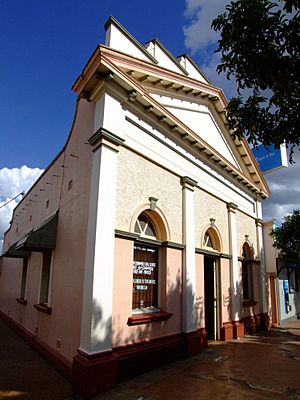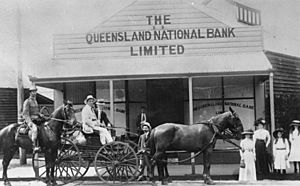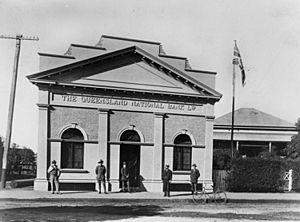Queensland National Bank, Childers facts for kids
Quick facts for kids Queensland National Bank, Childers |
|
|---|---|

Former Queensland National Bank, 2008
|
|
| Location | 50 Churchill Street, Childers, Bundaberg Region, Queensland, Australia |
| Design period | 1914 - 1919 (World War I) |
| Built | 1919 |
| Architect | Philip Oliver Ellard Hawkes |
| Architectural style(s) | Classicism |
| Official name: Queensland National Bank (former), Childers Travel World, Wrench & Cobb, Ye Olde Boutique | |
| Type | state heritage (built) |
| Designated | 21 October 1992 |
| Reference no. | 600610 |
| Significant period | 1910s (fabric) 1919-1943 (historical use) |
| Significant components | banking chamber, residential accommodation - manager's house/quarters, furniture/fittings, strong room |
| Lua error in Module:Location_map at line 420: attempt to index field 'wikibase' (a nil value). | |
The Queensland National Bank building in Childers is a historic former bank. It is located at 50 Churchill Street. The building was designed by Philip Oliver Ellard Hawkes. It was built in 1919. Today, it is also known as Childers Travel World, Wrench & Cobb, and Ye Olde Boutique. This building was added to the Queensland Heritage Register on 21 October 1992.
A Look Back: The Bank's Story
This building is made of stone and brick. It stands on the main street of Childers. It was the second building used by the Queensland National Bank at this spot. The bank built it in 1919. The design came from an architect named POE Hawkes from Maryborough.
The Queensland National Bank Begins
The Queensland National Bank was the first successful bank started in Queensland. It began in March 1872. A group of important Queenslanders started it. They wanted to create a bank that was controlled locally. This would help Queensland grow. The first office opened in Queen Street, Brisbane. Many people in Queensland chose to bank there.
By 1879, the bank handled all the money for the Queensland Government. By 1880, it held 40% of all deposits in the colony. It became very important to Queensland's economy. However, it was not the first bank in Childers. Other banks were already there in the 1890s.
Childers: A Growing Sugar Town
In the 1870s, the dense Isis Scrub was cleared for timber. Then, in the 1880s, people started promoting Childers. They wanted it to be a farming area. In 1882, the land around the town was divided into farms. Childers grew around the railway station. The Isis railway line opened on October 31, 1887. It was mainly used to move timber.
The railway also helped the sugar industry grow. Robert Cran, a mill owner, planned to build a sugar mill nearby. The Colonial Sugar Refining Company also built a large mill in 1893-94. By 1895, Childers was a major sugar-growing area. In 1903, Childers became the main town for the Isis Shire.
The Bank Arrives in Childers
Even though Queensland faced tough times in the 1890s, Childers was growing. This made it a good place for banks to expand. The Queensland National Bank first rented a timber building here. They also rented a house next door for the bank manager. The bank opened in Childers on July 9, 1900.
In 1909, the bank bought the property. In 1919, they built the new, grander building. POE Hawkes, the Maryborough architect, designed it. The new building had a public area with counters. It also had a strong room for money. There was a manager's office and a bedroom for the bank officer. A builder named Mr Steffensen built it for £1645. The old building was sold and moved away.
About the Architect: POE Hawkes
Philip Oliver Ellard Hawkes was born in 1882 in New South Wales. He worked in different cities before moving to Queensland. In 1910, he started his own architecture business. He designed several buildings for the Queensland National Bank. Many were simple timber buildings. However, the Kingaroy branch was a two-story brick building. It was also in a classical style, like the Childers bank.
What Happened Next
In 1943, during World War II, some bank branches closed. The Queensland National Bank branch in Childers closed on January 18, 1943. An accounting firm, Wrench and Copp, bought the building. They likely removed the bank counters then.
In 1948, the Queensland National Bank joined with another bank. This became the National Australia Bank. Later, the former bank building was bought by new owners in 1973. They ran a clothing shop called Ye Olde Boutique there for many years. After that, it became a real estate agency and a travel agency. In 2015, a doctor used the building.
Building Features
The former Queensland National Bank building is a single-story brick building. It has a special design to fit its corner spot. The roof is hidden by a stepped wall called a parapet. The front of the building looks grand and has a classical style.
The front has sections separated by flat columns called pilasters. There is a heavy triangular shape, a pediment, above the main entrance. The entrance has an arched doorway. Two arched windows are on either side of the door. The top part of the wall has a rough finish. The entrance doors seem to be original. They have curved glass panes and large brass handles.
The side of the building facing Ashby Lane is very plain. It also has a parapet that hides the roof. This side has two sash windows with sun hoods. The other side, facing the ANZ bank, looks similar.
Inside the Bank
Inside, the building has timber ceilings and smooth walls. Many original parts are still there. These include the manager's office and the strong room. Part of the teller's counter and cash drawers also remain. A new small office was built in one corner. A small hallway leads to what was once a bedroom. This room was divided into a kitchen and storage area, probably in the 1970s.
The bank building still looks much like it did originally. However, a large modern concrete building was built behind it. A passageway connects the two buildings.
Why It's Important
The former Queensland National Bank building in Childers is listed on the Queensland Heritage Register. It was added on October 21, 1992. It is important for several reasons:
Showing Queensland's History
This building shows how Queensland developed. It was built for a bank that served Queensland's needs. The quality of its design shows how important this local bank was. Childers was a busy center for growing sugar at that time.
A Typical Bank Building
The building shows what a regional bank looked like back then. Its classical design made it look strong and trustworthy. The layout also included a secure strong room. It even had space for staff to live.
Beautiful Design
This building is well-designed and detailed. It makes Churchill Street look very nice. The street itself has many old buildings that fit well together.
Connected to Important People
The building is linked to the architect POE Hawkes. He designed many banks for the Queensland National Bank. This one is one of his most important works. It is also connected to the Queensland National Bank itself. This was the first bank started by people in Queensland.



